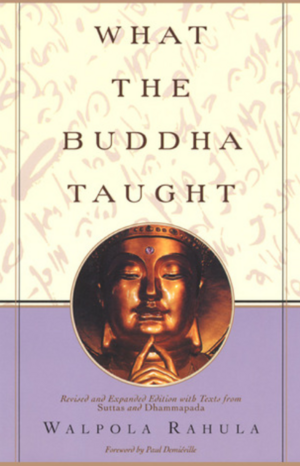What the Buddha Taught
Jump to navigation
Jump to search
What the Buddha Taught is a text by Walpola Rahula that explains the fundamental principles of Buddhism in a manner accessible to beginners and non-Buddhists.
The author states:
- I have discussed in this book almost everything which is commonly accepted as the essential and fundamental teaching of the Buddha. These are the doctrines of the Four Noble Truths, the Noble Eightfold Path, the Five Aggregates, Karma, Rebirth, Conditioned Genesis (Paṭiccasamuppāda), the doctrine of No-Soul (Anatta), Satipaṭṭhāna (the Setting-up of Mindfulness).[1]
From the Preface:
- The book...is a luminous account, within reach of everybody, of the fundamental principles of the Buddhist doctrine, as they are found in the most ancient texts, which are called “The Tradition’ (Āgama) in Sanskrit and ‘The Canonic Corpus’ (Nikāya) in Pali. Dr. Rahula, who possesses an incomparable knowledge of these texts, refers to them constantly and almost exclusively. Their authority is recognized unanimously by all the Buddhist schools, which were and are numerous, but none of which ever deviates from these texts, except with the intention of better interpreting the spirit beyond the letter... But the aspect of Buddhism here presented by Dr. Rahula — humanist, rational, Socratic in some respects, Evangelic in others, or again almost scientific — has for its support a great deal of authentic scriptural evidence which he only had to let speak for themselves.[2]
References
- ↑ Rahula 1959, Preface, by Walpola Rahula.
- ↑ Rahula 1959, Forward, by Paul Demiéville.
Sources
- Rahula, Walpola (1974), What the Buddha Taught (PDF), Grove Press
